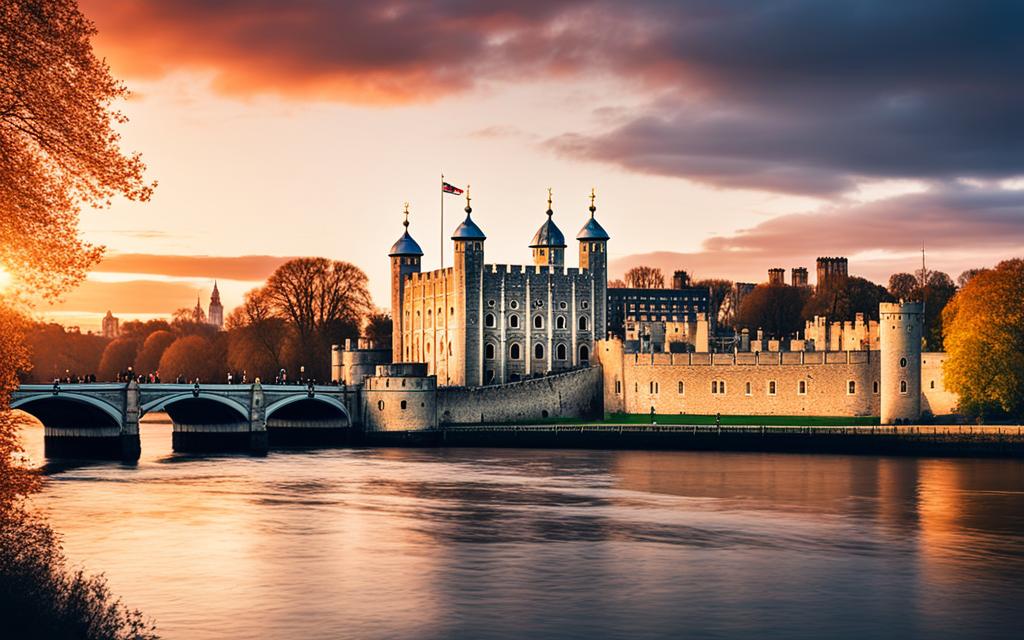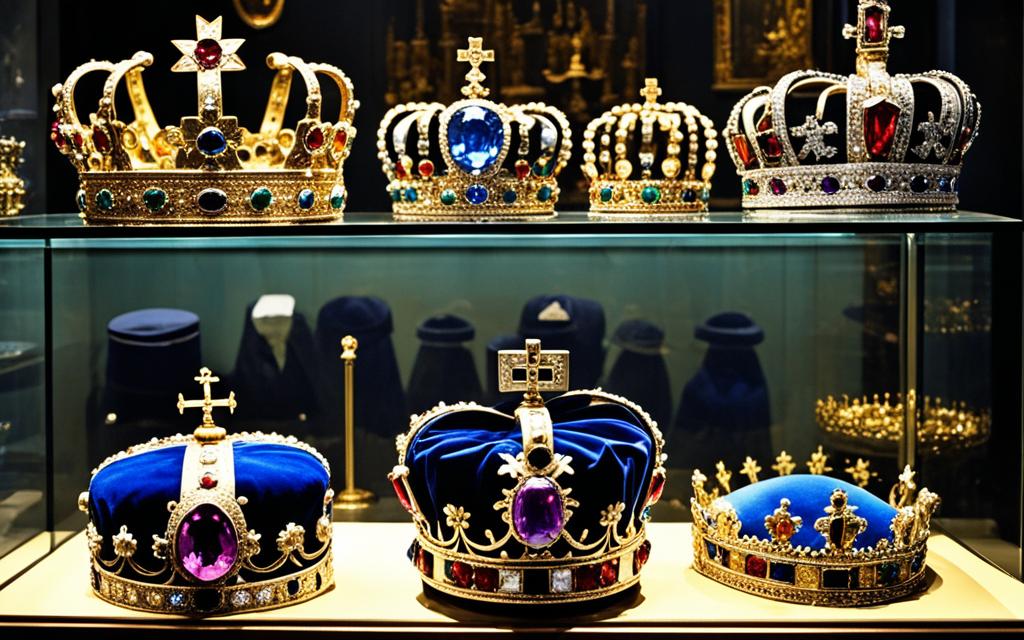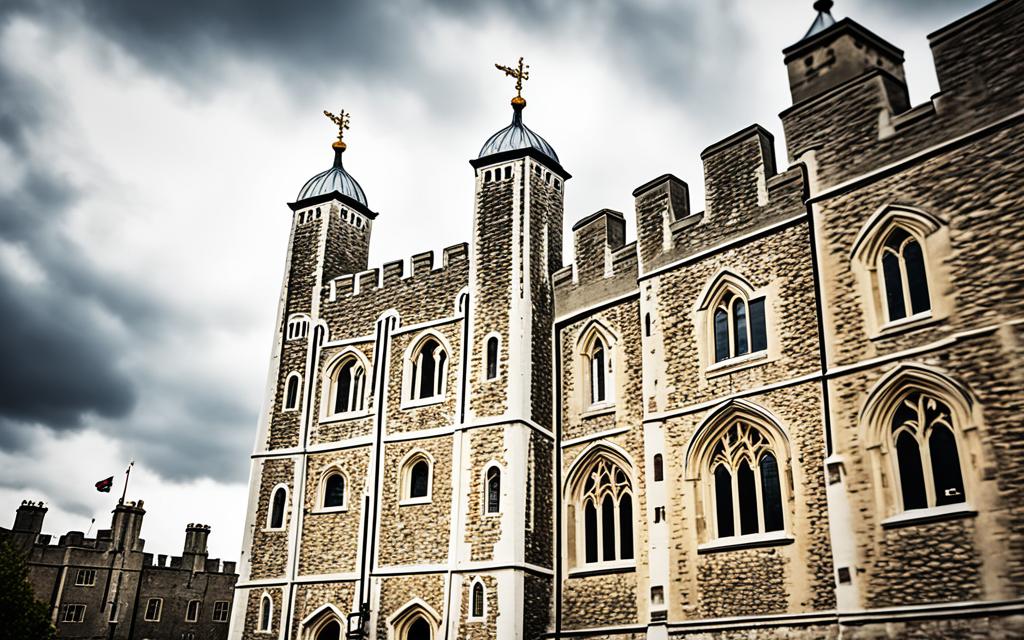Looking at the huge walls and turrets of the Tower of London, you feel amazed. It’s full of history. Built in 1066 by William the Conqueror, it started as a royal palace and defense. Since then, it has been a home for kings, a jail, a place to keep weapons, and much more.
This UNESCO World Heritage Site shows the UK’s strength and long history. It welcomes millions of people every year. People come to see its beauty and learn about its past. From the White Tower to the Bloody Tower, the Tower of London is like a living history lesson. It shows us the stories and impact of its rich culture and history.
Key Takeaways
- The Tower of London is a historic castle located in the heart of the UK’s capital city, London.
- The castle was originally constructed in 1066 by William the Conqueror as a royal palace and defensive fortress.
- Over the centuries, the Tower of London has served a variety of purposes, including as a royal residence, a prison, an armory, a treasury, and a menagerie.
- The Tower of London is a UNESCO World Heritage Site, recognized for its outstanding universal value and importance as a cultural and historic landmark.
- The castle attracts millions of visitors each year, who come to marvel at its rich history and architectural splendor.
The Tower of London: A Iconic Landmark
The Tower of London dates back to 1066. It was built by William the Conqueror. This castle has seen much over the years. It was a home to kings, a jail, and the place where many were executed. Some of those executed included Anne Boleyn and Catherine Howard.
Architectural Marvels of the Tower
The Tower boasts many architectural wonders. The White Tower is at its heart, made of stone in medieval times. The Bloody Tower, once a jail, is also famous. These buildings have survived many years, impressing visitors with their beauty and history.
The Tower’s Role in British History
The Yeoman Warders, or “Beefeaters,” have guarded the Tower of London since the 16th century. They are key in its history and culture. These guards are a living part of the Tower’s importance as a symbol of the UK’s past.

Exploring the Tower of London
When you visit the Tower of London, there’s much to see. The Yeoman Warders, or “Beefeaters,” are quite a draw. Since the 16th century, they’ve been guarding the castle. They also lead tours for guests.
The Yeoman Warders (Beefeaters)
The Yeoman Warders, or Beefeaters, are key to the Tower’s history. They’ve kept the castle safe for centuries. Their role makes the Tower special and well-known.
The Crown Jewels of the United Kingdom
The Crown Jewels of the United Kingdom are a must-see at the Tower. They’re in a special place inside the castle. These jewels highlight the Tower’s significance in British royalty.

The Tower of London in Popular Culture
The Tower of London has fascinated many for years. It’s known for its dark past, like the prisoner executions and what happened to Anne Boleyn. The castle’s look and history have inspired lots of books, movies, and shows, including Shakespeare’s work. The Bloody Tower is especially famous. It’s where the Princes in the Tower mysteriously vanished, which led to lots of stories and interest.
The Tower’s scary history has drawn people in for a long time. Stories of betrayal, prison, and death hit deep. Like when Anne Boleyn lost her head. Or the mystery of the young princes who disappeared. The Tower is a key part of Britain’s scary past.
Books and movies often use the Tower’s history for their stories. For example, Shakespeare’s “Richard III” and the Showtime series “The Tudors”. The Bloody Tower is often at the center of these tales. Its link to the lost princes keeps people guessing and intrigued.
The Tower of London’s dark yet grand story keeps it well-loved. From the Crown Jewels to the gruesome end for some, its tales live on. It stands for both the beauty and the fright in Britain’s past. The Tower of London keeps catching people’s imagination everywhere.
The Tower Green and Bloody Tower
The Tower of London has a dark tale. It was a place where many famous people were executed. The most notable one was Anne Boleyn, who was the second wife of King Henry VIII. She was executed on the Tower Green in 1536. It marked the end of a difficult time between her and the king.
Anne Boleyn’s Execution
On May 19, 1536, Anne Boleyn faced her fate on the Tower Green. She was charged with serious crimes like adultery and treason. A special court sentenced her to death. Her execution at the Bloody Tower highlights a very sad part of its history. This tower was a prison for many of the king’s opponents.
Other Notable Executions
The Tower of London saw more than just Anne Boleyn‘s execution. Catherine Howard, Henry VIII’s fifth wife, also met her end here. So did Lady Jane Grey, who briefly ruled as Queen for nine days. The Bloody Tower is also linked to the mystery of the Princes in the Tower. Two young princes disappeared and were likely killed on their uncle’s command, Richard III.
The Tower of London as a UNESCO World Heritage Site
In 1988, the Tower of London was named a UNESCO World Heritage Site. This title celebrates its exceptional value as a cultural and historic treasure. It’s now among the world’s top well-kept and famous castles.
Significance and Conservation Efforts
The Tower of London has a 900-year history that includes being a royal home, a prison, and an armory. It also holds the Crown Jewels of the United Kingdom. Today, efforts in conservation keep this castle fascinating for visitors worldwide. It preserves the UK’s rich history.
The Tower of London has many famous parts. From the White Tower to the Bloody Tower, it tells dark but captivating stories. This makes it a favorite stop for those visiting the UK. As a UNESCO site, the Tower stands as a symbol of our cultural legacy. It brings awe and inspiration to its visitors.




